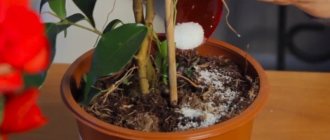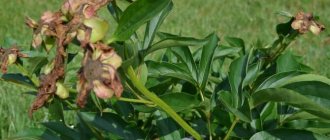Preparing peonies for winter must be done within a certain time frame and correctly. This determines how well the peony bushes will prepare for the next season and will not suffer from frost in winter or from frost in early spring. Caring for peonies in the fall and preparing bushes for winter has a number of features. At this time, 1-1.5 months after flowering, renewal buds are formed and the root system develops. Therefore, it is very important to do everything correctly in order to get lush flowering next season. Peony requires fertilizing and watering, especially during the formation and formation of renewal buds, which occurs shortly after the end of flowering. Therefore, in the fall, peony bushes also need care. During the season, in spring and summer, caring for peonies does not contain any special techniques. This includes watering, loosening the soil, mulching, removing weeds, and trimming fading buds.
Caring for peonies in autumn
What should you do in the fall, when your peony bush is actively preparing for winter?
In the fall, it is recommended to carry out the following measures for caring for peonies:
- Loosening the soil, no deeper than 5 cm within a radius of 50 cm, so as not to damage the roots.
- Mulch the soil around the bushes.
- Remove fallen and dry leaves, petals, faded flowers and buds to prevent fungal diseases
- To prune bushes in autumn, it is advisable to do this as late as possible.
- Shoots and leaves in the fall are cut off as close to the ground as possible and burned.
- Feed the peony bushes.
- If replanting or dividing is required, autumn is the best time for this.
- Abundant watering in late autumn contributes to a good wintering.
Organic fertilizers
Organic matter ensures plant resistance to frost - it will better withstand the cold period. This fertilizing is applied after pruning the plant. The plant needs:
- wood ash - 150-200 g;
- bone meal - 150 g;
- compost or humus - 5-6 kg;
- chicken droppings or manure - 3 liters of 5-day infusion (⅓ with water).
All components are dissolved in water at room temperature and the solution is carefully poured onto the ground within a radius of up to 30 cm from the bush. A third of the wood ash and bone meal can be left so that after active watering you can sprinkle the cuts, which are made just below the ground level.
Feeding peonies in autumn
After active growth and flowering, by autumn the root system of peonies is greatly weakened. Namely, it is at this time that the formation of growth points and roots begins. In order for new roots to successfully form and the plant to enter winter prepared, it needs to be fed.
The root system of peonies accumulates minerals and useful substances in the fall for the active growth of the bush in the spring and the formation of large inflorescences.
In the fall, it is best to feed peonies from mid-September to mid-October, 1-1.5 months before pruning and the first frost. It is at this time that the peony bush most actively accumulates strength and nutrients.
Other procedures: watering, transplanting, disease prevention and treatment
You can water peonies after autumn pruning, but not too much, especially for ITO varieties.
If the bushes have grown a lot, they should be replanted. This procedure must be carried out during the velvet season (late August - first half of September), when the weather is warm, dry. The peony will get used to the new place, take root and quickly grow in the spring.
In spring and summer, it is better not to plant or replant the peony - all the plant’s energies are aimed at flowering and producing seeds, so the risk of death is very high.
Whatever feeding method you choose, you need to apply fertilizer very carefully so that the additives do not get on the root neck of the peonies.
How to properly plant peonies in the fall:
- Choose fertile, loose soil, preferably black fallow (an area that has been “resting” for a year) or land on which legumes have previously grown. The landing site should be sunny, not windy, away from buildings and trees.
- 4 weeks before planting, dig ditches with a diameter and depth of up to 0.5 m, at a distance of 1–1.5 m from each other. Place drainage at the bottom: sand, gravel and water to settle the soil.
- Mix chernozem with humus, sand, manure, peat and ash in a 1:1 ratio. Pour the mixture into the hole and mix with garden soil. You can also add urea, superphosphate, and ferrous sulfate.
- Trim the peony stems to 15 cm. Carefully dig up the old bush. Shake off the soil and leave the dug bush in the shade for 2 hours so that the roots are not brittle.
- Inspect them, remove damaged and dried ones. Cut large ones at an angle of 45–60º, leaving a length of 10–20 cm. Sprinkle the sections with crushed charcoal. Place the roots for half an hour in a light pink solution of potassium permanganate.
- After soaking, plant young peonies in separate holes, placing the buds at a depth of 4–5 cm from the surface. Each division should have 2–3 shoots, 3–4 roots and growth buds.
The most gentle method of dividing a dug up bush is to plant it on a 40–50 cm stake. The bush will spontaneously disintegrate into the required sections.
Benefits of autumn feeding of peonies
- In early spring, the buds will be much larger and stronger.
- The peony bush will grow faster and flowering will be more luxuriant.
- The bushes are stronger and quickly increase in size
In autumn, phosphorus-potassium fertilizers are needed. Nitrogen-containing fertilizers are used for spring feeding to enhance the growth of the above-ground part of the plant. When young shoots grow in the fall, they will freeze when it freezes.
Peonies need to be fertilized especially carefully from mid-September to mid-October, preferably 1–1.5 months before pruning. Plants should be fed from the third year after planting.
Tips for gardeners
Peony is considered an unpretentious plant. In a sunny, open area they will bloom well and actively with minimal care. Only the peonies themselves can deplete the soil for peonies.
When transplanting to a place where a similar bush has already grown, it is worth lifting the entire thickness of the soil and replacing it with fresh soil, in which similar perennials have never grown. Before transplanting, the roots are washed with a weak solution of potassium permanganate or the finished preparation Maxim and dried to stop the flow of sap and make them softer and flabby. When transplanting, you need to achieve full contact of the roots; you cannot press or crush them. Trampling the soil is also prohibited, but you can water it abundantly.
Stores also sell special combined fertilizers for peonies. Some universal flowers are also suitable for this type of flowers - MicroCrop, ETISSO, Bona Forte for peonies and roses. But with good watering, lush flowers will delight without expensive fertilizing.
When to prune peonies in the fall
The most suitable period is considered to be late autumn, before the first frost. This time usually falls at the end of October or beginning of November. Premature pruning will deprive the plant of essential nutrients, and late pruning can cause death. As a last resort, if you need to prune the shrub earlier, leave three or four leaves on each stem. This way, the peony will be able to accumulate strength to lay buds next year.
Autumn pruning of peonies is also required so that in winter the plants do not waste energy on the above-ground part instead of developing the root system. Another reason is fungal and bacterial diseases, which often affect leaves in the fall.
In autumn, pruning peonies should be postponed until the weather gets colder. A sure sign that the plant is ready for pruning is that the branches are lowering to the ground, the leaves are dry and withered; they will no longer be needed. This indicates the end of physiological processes and readiness for the winter rest period. In case of infection, preparation for winter should be carried out earlier by treating the cutting areas and the soil around with a fungicide solution.
Mineral fertilizers
Mineral fertilizers can be applied in dry or dissolved form. Since they directly stimulate the growth of the plant's thick main roots, these components are added immediately after flowering to allow the plant to recover and gain underground mass.
Composition of the mineral mixture:
- superphosphate - 2 parts;
- potassium sulfate - 1 part;
- potassium monophosphate - 3 parts;
- potassium magnesia - 1 part.
For watering 1 sq. m. area you need to dissolve 100 g of the finished mixture in a bucket of water. If the plant grows in a new place for no more than 3 years, you can limit yourself to potassium and phosphorus, 15 g per bucket. Such components, like organic matter, are suitable for any type of soil.
You can also add the mineral mixture to the second feeding. In this case, any complex fertilizer, for example Agricola, will do. There is no point in focusing on specific mineral compositions.
Rules for pruning peonies in autumn
Peony stems are completely cut off in the fall, before the first frost. If you need to prune the bush earlier, leave at least 2-3 leaves on each stem, which will process useful elements from the root system. In this way, the peony will be able to accumulate strength to lay buds next year.
When cutting flowers from a bush in the summer, it is also necessary to leave at least three leaves on the stem.
Sequence of pruning peonies:
- preparation and disinfection of instruments;
- removing shoots, leaving a small stump (1-2cm) so as not to damage the growing points;
- In tree-like peonies, you cannot remove skeletal branches, but only leaves;
- after pruning, sprinkle fertilizers, loosen them, mixing them with the top layer of soil;
- remove and burn plant residues;
Basic Rules
- Only those bushes that are 3 years old or more are fertilized;
- If autumn is dry and warm, preference is given to liquid complexes; During the rainy season, granular mixtures are better;
- For sandstones and depleted soils, fertilizing is applied 2 times with a mandatory interval of 2 weeks;
- Alkaline and slightly acidic soils are fed with superphosphates in order to improve the quality characteristics of the soil layer;
- Organic and potassium-phosphorus compositions are applicable for every type of soil.
Mistakes when preparing peonies for winter
The main mistakes when preparing peonies for winter:
- pruning too early, before the first frost, disrupts the formation of renewal buds;
- do not immediately remove withered foliage and cut shoots - the buds and buds are affected by fungal diseases;
- there are not enough nutrients in the soil - there will be few buds;
- if there is an excess of nitrogen, the shoots may be without buds;
- Peonies are not properly covered for the winter.
Peony planting depth
When planting a peony, do not bury the plant's growth buds, otherwise you will not get lush flowering. The correct depth is that the growing points should be 3-5 cm below the soil surface.
- if the peony is planted incorrectly, it needs to be replanted in the fall
- the peony is not planted deeply - the bush suffers from frosts in the spring
- The bush is planted very deeply, many shoots are formed, but few buds.
Disease prevention in autumn
Prevention of fungal diseases of peonies in the fall after leaf fall involves treatment with copper sulfate (3–4%) or Bordeaux mixture (2–3%).
And to increase peony resistance to diseases, it is recommended to use phosphorus-potassium fertilizers and microelements, while eliminating excess nitrogen. The drugs must be alternated.
Folk remedies
In addition to ready-made fertilizers and artificial mixtures, you can feed the peony with folk recipes. Their tasks are the same - increasing the flowering period and the size of the flower itself. Plus home remedies are completely safe. Time-tested recipes:
- ground coffee (can be already brewed) - up to 100 g per square meter. m.;
- tea leaves (you can also use used tea bags or the contents of the teapot after drinking tea) - up to 200 g per square meter. m.;
- banana flour - banana skins are dried in the sun or in the oven at low temperature, ground and scattered (up to 100 g per sq. m.);
- infusion of eggshells (from 10 eggs per bucket of warm water);
- bread infusion - rye or black bread is dissolved in warm water and poured under a bush after 12 hours;
- yeast - live, frozen and dissolved in warm water (up to 100g per bucket of water/1 sq. m.);
- nettle infusion - a decoction or infusion of green mass in any concentration.
Instead of water, you can also use herbal decoctions or infusions to dissolve mineral fertilizers. They can also serve as a means of irrigation. Fleshy stems and leaves never need too much liquid.
Sheltering peonies for the winter
Sheltering peonies is necessary, since the growth buds are located close to the soil surface, at a depth of only 3-7 cm, and they must be protected from frost.
Depending on climatic conditions, covering peonies for the winter is slightly different. But where it is necessary to protect the bushes, the general principles are as follows:
- After pruning the bushes in the fall, they need to be hilled up.
- A layer of mulch at least 15-18 cm thick should be laid on top.
- For tree peonies, the root system is covered with a layer of peat of 20-25 cm, and the stems with lutrasil.
- Sawdust, spruce spruce branches, high-moor peat, dry leaves, humus or compost are used as covering materials.
- You cannot use cut foliage of the peonies themselves or straw, so as not to cause infection.
- In winter, additionally cover the peonies with a layer of snow to protect them from severe cold.
- When removing material in the spring, you can leave some of it as mulch.











